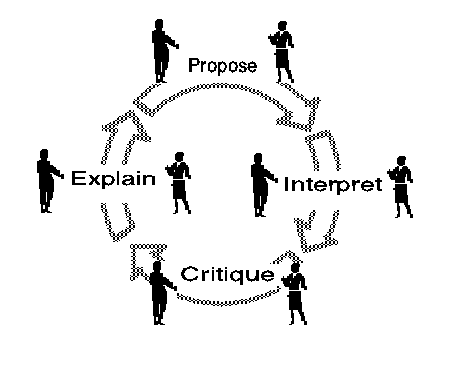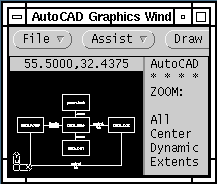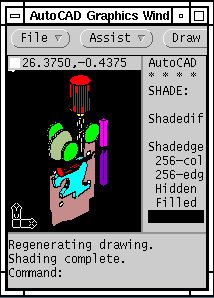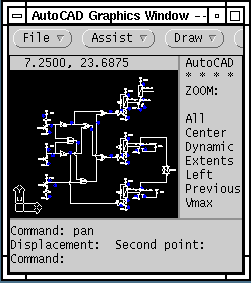Interdisciplinary Communication Medium (ICM)
home page
Interdisciplinary Communication Medium (ICM)
Multidisciplinary Concurrent Engineering
Through Shared Graphics


fruchter@cive.stanford.edu
Abstract. The objective of this project is to develop a computer environment
which will improve the communication among designers in an interdisciplinary team.
We present a Propose-Interpret-Critique-Explain (PICE) paradigm as the communication cycle
for collaborative conceptual design. We explore and test the PICE conceptualization by modeling it
with a software prototype,
ICM , that
integrates graphic representations of a shared 3D model of and AI reasoning tools about,
the evolving design. ICM provides a graphic environment as the central interface to reasoning tools,
to support design. The graphic environment enables designers to explore the
toplevel functional object definition of the future device , as well as the
AutoCAD form model of the device. The goal of the ICM prototype is to help improve the quality of
design by supporting: (1) improved concurrent engineering, (2) increased number of explored alternatives,
(3) multi-criteria evaluation, (4) reduced product design cycle, (5) capture of design intent,
(6) smooth electronic transition to later stages of product development.
This document is currently under construction.

Outline

Integration and Interoperability are Necessary and Now Possible!
- Sharing of a 3D Model of the Artifact and Exchanging Non-Graphic Information
- Graphic Modeling of Form, Function, Behavior
- Symbolic Modeling of Form, Function, Behavior
- Design Theory: Propose-Interpret-Critique-Explain Communication Cycle
- Technical Integration: CAx --> CAx --> ... --> CAx

Traditionally, there has been much difficulty in communicating
- design intents,
- decisions, and
- problems across disciplines.
Consequently the quality of designs is decreased by:
- Tasks such as identifying,interpreting, extracting and re-entering relevant information from different discipline perspectives are ERROR-PRONE and TIME CONSUMING.
- CONFLICTS are not noticed or resolved early enough in the design process.

Goal:
Improve early real-time cross-disciplinary communication of multi-criteria design intents, decisions, and probles.
Scope:
Collaborative Concurrent Conceptual Design
Objective:
Provide support for dynamic changes and multidisciplinary information needs in mechatronic design.
Research Tasks:
- Fromalize a collaborative conceptual design methodology
- Implement the formalized methodology as a software prototype
- Test the prototype
Throughout the design process, designers use Form, Function and Behavior models in both the graphic and the symbolic world. The graphic world plays a central role in exploring, editing, documenting, and explaining design intents. The symbolic world plays a central role in reasoning and evaluating the design. One of the main objectives of this research is to explore the link between these two worlds in the mechatronic domain.
Publication
PICE - Design Communication Cycle
Throughout the design process, designers
- Propose design alternatives
- Iinterpret proposals into discipline models,
- Critique discipline models,
- Eexplain critique results.
Linking Graphic and Symbolic Models in the PICE Communication Cycle
Propose. Designers propose solutions for a mechatronic device using a shared 3D graphic model.
Interpret. The interpretation activity results in the identification of relevant features of the shared 3D graphic model within a specific discipline context. The interpretation is represented by semantic annotation of the CAD graphic entities with their meaning within the selected discipline context.
Critique. The critique activity uses knowledge-based analysis and evaluation of a symbolic discipline model to derive the behavior and to compare the behavior to functional requirements.
Explain. The explanation capability is currently being implemented. It represents a symbolic trace of the performance problems and suggestions for design modifications, as well as the visualization of the problems projected back onto the graphic model.
Illustrative Example
In order to illustrate the potential use of the proof-of-concept prototype we use as a test case an example selected from 1992/1993 ME210 projects. This is the Automobile Door Cinching project sponsored by GM. Many different systems interact within the limited space inside the car doorframe. With limited space available, the challenge of adding another subsystem to the door quickly becomes a packaging problem.
The goal of this project was to design and build a door latch system that combines the functions of latch, power lock and cinching into a single assembly. The proposed solution is shown by the schematic subsystem interaction of the automobile door cinching system.

ICM System Integration and Interoperability Architecture
The Interdisciplinary Communication Medium (ICM) tighly integrates graphic representation and AI reasoning about the evolving design.
Graphic CAD
systems provide a form modeler and a visualization tool for proposing and modiying a design. Knowledge-based systems provide symbolic environments for reasoning about the function and behavior of the design.

ICM uses a central, shared 3D graphic model which is connected to multiple symbolic models that provide automated reasoning about the design from multiple discipline contexts. The connections between the graphic model and the symbolic models are modular, allowing symbolic context models to be added or removed independently of other models.
ICM uses AutoCAD to store the central graphic model. Within AutoCAD we have used AutoLisp, DCL and ADS C functions to build the interpretation capabilities. The symbolic models have been developed in Prokappa, which is an object-oriented knowledge engineering environment.

Exploring the Cinch Device with ICM
Toplevel Module for Functional Object Definition
AutoCAD Toplevel Functional Object Definition
 Click on the drawing to view it full size
Click on the drawing to view it full size

AutoCAD Cinch Model
 Click on the drawing to view it full size
Click on the drawing to view it full size

Drive Train KB
- Problem Statement: Drive train design today includes many quantitative and qualitative approaches that are often distributed among many differentexperts and manuals. A non-expert designer needds a better way to quickly design and evaluate a drive train that will meet the requirements of the customer. A Drive Train KB can assist in this design process.
- Goals for Drive Train KB Module
- The KB should allow a designer to confidently select appropriate drive train elements given a set of constraints.
- The KB should allow a designer to identify constraints dictated by geometry, material on hand, spatial requirements, performance criteria, etc.
Motor KB
- Problem Statement
- Too many motors with too many different characteristics
- Not enough knowledge for operation of the motor
- Need for computer-based component libraries
- Need for friendly interface to users
- Goals for Motor KB:
- Assist designer in selecting a motor
- Offer additional information, such as, motor characteristics, evaluation of selection, suggestions
- Design a friendly UI
- Motor KB-Centered Overview
Note, that such KB-centered overviews apply to all the KB modules.
Circuit Designer
- Problem Statement:
The preliminary design stage is characterized by incomplete information and qualitative solutions.
- Research Question: Can a circuit analysis tool provide useful suggestions during the preliminary design stage
- Motivation:
- Need to accommodate incomplete and qualitative information in analysis
- Incompatibility between output formats and designer's interests
- Difficulty to assign multiple functions to circuit elements
- Promote experimentation
- Implementation
- Modeling
- AutoCAD used for rapid circuit construction and semantic annotation
- ICM interface used to generate context interpretations
- Symbolic modeling, critique, and suggestions
- KB Domain
AutoCAD Electrical Circuit of the Cinch Switch Model
 Click on the drawing to view it full size
Click on the drawing to view it full size

Improve quality of design
- Improve concurrent engineering
- Increase number of explored alternatives
- Support multi-criteria evaluation of design
- Reduce product design cycles
- Capture design intent
- Smooth electronic transition to later stages of product development

Testing
- Demo feedback from Cinch project team members
- ICM sheell testing with ME210 teams
- PICE cycle testing with one ME210 team
Tech Transfer
- SIMA project liaison and other industry affiliates
- Workshops on Concurrent Multi-disciplinary Engingeering
- Summer Workshop for SIMA Affiliates, sponsored by SIMA, July 14-15, 1994
- Hughes Workshop, sponsored by Hughes Aerospace, November 10-11, 1994

- We elaborate and formalize a theory of interdisciplinary communication as a Propose-Interpret-Critique-Explain cycle.
- We tightly integrate graphic and symbolic modeling.
- The research includes technical integration:
- Open system integration architecture that allows addition or removal of different reasoning modules as needed.
- Central graphic modeling environment that enables sharing of 3D graphic model of the product.
- Semantic modeling and exchange of non-graphic information that supports interoperability.

- Test the generality of the modeling capabilities of the ICM shell by re-using it within the mechatronic system design domain
- Define mechanism for re-use of engineering knowledge
- Associate textual suggestions with graphic model
- Implement a more robust software environment
- ...

Larry Leifer- Principal Invetigator
Renate Fruchter - Research Associate
George Toye - Research Associate
Mark Clayton - Ph.D. Candidate, CE Department
Madhu Prasad - Master Student, ME Department
Kurt Reiner - Ph.D. Candidate, ME Department
Omar Tawakol - Master Student, ME Department
Mark Tsai - Post-Master Student, AA Department

Renate Fruchter










 Click on the drawing to view it full size
Click on the drawing to view it full size

 Click on the drawing to view it full size
Click on the drawing to view it full size

 Click on the drawing to view it full size
Click on the drawing to view it full size





